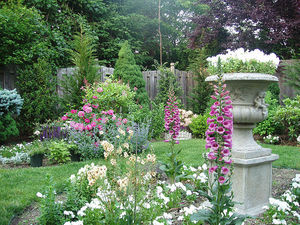With the weather warming up, it’s been sunshine and green grass for a whole week. Time to get outside and spruce things up! It’s springtime fever at its best, and no one can deny the effects of a few good hours of sun. It’s beneficial to get outside, and not just physically either. It’s been proven that just twenty minutes in the sun a day can vastly improve the mood and general well being of a person.
Being the early bird I am, as soon as I saw the sun come out I immediately decided it was time for a project. With that decided, I looked at my plain gray sidewalk and started on a plan to spruce it up a little. [My family and I recently poured that sidewalk on our own, which was one hefty project. It was more than worth it, with all the mud we’ve suffered through this winter.]
That being said, it was time for a little greenery, and how better than to put in a few raised beds along the path to liven things up a bit? With that in mind, I headed to the local hardware store in search of some inspiration.
You can’t put a price tag on inspiration, but you can spend a few minutes asking around and combing the shelves. Looking for ideas is good, but there’s no substitute for asking a more experienced gardener. Even if the employees don’t know much about plants, the customers usually do, and quite a few of them have valuable advice for anyone who will listen.
Now, on to the practicals of this job. The soil surrounding my sidewalk is almost solid clay, which makes it terrible for growing anything. That was the reason to put in either raised beds or large planters, rather than putting down a ground flower bed. Because of my busy schedule, it also couldn’t take a lot of time or effort.
While thinking along these lines I decided not to buy a pre-made planter or a raised bed kit. The biggest reason was the expense, as even a relatively small planter made of anything but plastic can cost a small fortune. But, I did decide I could duplicate the raised bed idea with very little thought on my own for half the price. The list of materials I decided on are as follows.
Pre-treated 10’x2″x6″ timbers, about 6
Pre-cut Rebar stakes, about 3/4″ diameter and 20″ long, about 20 of those
Gold Decking Screws about 2 1/2″ Long about 1lb
3 or 4 Bags of Potting Soil [I used the store brand, but you could use whatever your wanted]
And finally, about 6 different types of annual plants. This time of year you can buy them at hardware stores, at home improvement stores, nurseries and of course your local mega-stores like Walmart,
I have all of my own tools for this sort of thing, this is what the tool list would look like though, if you needed one:
An electric circular saw
An electric drill
A measuring tape and pen
A good hammer
a trowel
and some water for your plants
Oh, and some safety glasses and ear plugs or muffs
I started out by cutting and measuring my boards. The beds I were making measured 5′ long x 2.5′ wide x 1′ tall and I wanted two. This was mainly because you just cut four of your boards in half, and two of them in quarters, and you’re done with cutting. Now your objective is to screw the boards together to make four frames, using two of your short boards and two of your long boards to form a rectangle. [See figure One] Don’t forget to wear the proper safety equipment while doing this!
Seeing as it’s not very tall, what I did was stack two of these frames, and then pounded the rebar stakes into the ground to keep them in place. Because of the stakes, there was no need to screw the frames together. Gravity did most of that. The rebar stake did the rest. [See figure two] The placing of the stakes on the INSIDE of the box gives it more stability, and it looks better.
Believe it or not, that’s all there is to it! It only took one hour to make these two simple beds, from cutting to staking them down.
As a side note if you want to put these on a deck or patio or some other place where you can’t drive the stake, then you will have to screw your frames together and put some type of weight in the bottom. A few bricks would be good, but rocks would do just as well. Since you have to screw the frames together, you’ll need a small brace, probably a 1″x4″x4″ scrap of lumber to hold the two together. [See figure three]
All you have to do now is fill the planters with potting soil and set your plants! I recommend annuals, just because that way you could even take down your beds over the winter if you wanted without worrying about transplanting, My favorites are pansy’s and violas, but you could use whatever type you prefer. The only note of caution I would tender is not to over water these flower beds. If the soil in the raised bed becomes to heavily saturated with water, it could start to eat away at even the most expensive of pretreated wood. And if you have it on a patio or deck, the water would eventually leach out the bottom.
Other than that, these beds are a breeze to care for. Even though I made mine very large, it would be easy to duplicate this pattern on a smaller scale for decks and patios, or a larger one for vegetables. It would even be easy to give this planters a fresh look by covering them with a stain, a wood finish, or even some exterior paint!
This pattern truly is simple, affordable and will add greenery and simplicity to any walkway, sidewalk, patio or deck space. So, why don’t you give it a try? I guarantee it will be worth the effort!


